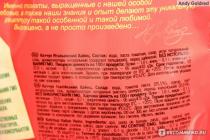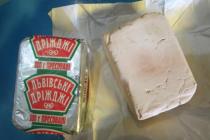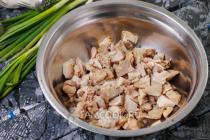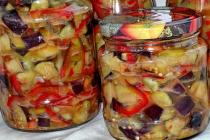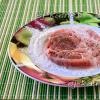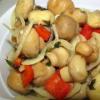Peperomy is a perennial plant that belongs to the seven hundreds of peppers. This flower has a large number of species that may differ in the size of the plant itself, the color of its leaves, their size, shape and structure. The only thing that is common to all kinds of peperomy is simplicity of care. Peperomy, care at home for which it does not require any excess effort when landing, caring or reproducing the plant.
Number of light
Peperomy may have in its composition of plants, in whom foliage has both green and bright color of the leaves, and this is an important indicator of what amounts of light need every flower. Those species whose leaves have a bright color, prefer large amounts of light, the main thing that would not be straight rays of the sun. If such a flower lacks light, then its foliage acquires a simple green color. The decorativeness of the plant is lost from the lack of illumination, its originality.
As for those grades whose leaves originally have a green color, then for them is characterized by a sexual lifestyle, they do not need a lot of light.
What both types of peperomy grew correctly and maintain their decorative properties, you need to choose a suitable location for them. If there is no such a window sill in the room, where the sunlight did not fall directly on the plant, then you should take measures to fence it from the Sun through paper, gauze or a similar material that will miss the right amount Sveta.
No cold and draft
Most of all, peperomy does not like drafts, so you need to carefully choose a place where to put a pot with this flower. These plants are truly indoor and does not grow out on the street, and in any other conditions where there are temperature differences, the movement of air masses and drafts. The flower is most comfortable, being on the cozy and warm windowsill, where there are no cracks. Comfortable temperature at which peperomy feels normally, it is considered eighteen - twenty-two degrees.
It is important to monitor the temperature of the soil itself, because the roots of the flower are thin, and short, therefore they react strongly to the temperature differences, especially in the cold. If the peperomy plant has changed the appearance of the leaflet, it is deformed, it means the root system is cold in the soil. If the soil in the potted temperature indicators is equal to eighteen - twenty degrees, it will be the most optimal temperature for the flower.

Wrong watering
Despite the fact that the peperomy flower is tropical in its roots, but it does not need a very strong watering. During the occurrence of the heat, the plant will need a little more moisture, but not much. An important condition for irrigation is observing measures in the amount of moisture that falls into the flower. Another important element is drainage. If the soil is old and dense, then the moisture goes out of the pot for a long time, and stagnation can be formed, which is very dangerous. For this room plant, excess moisture leads to the fact that the stem begins to soften, the leaves begin to black, and then fall. You can help peperomies only at the very beginning when the plants simply began to wither the leaves. If irrigated was too big and the foliage began to wither, you need to act immediately, otherwise it will be too late. The main rule here, remove the flower from watering for a while that the land is completely dried, or even longer.

Air humidity
Despite the fact that the plant is a leaving of the tropics, where the air humidity is high, it is rather not bad and in the new conditions, where the air is much land. Room flower can do without additional moisturizing, and its development will be quite normal, however, if there is a desire to grow a big and beautiful plant, then it is better to provide additional moisturizing to him. How to care for a flower in winter will not cause questions, but in the summer you need to spray the plant. It should be known that if the plant has glossy leaves, then water can be sprayed directly on them, and if the sheets are terry, then the spraying is not far from the peperomy, so that the drops on the leaves did not fall at all. AT winter Moisturizing the flower is not required, the exception is the case if the pot is near the battery and the air near the plant is reheated. In this case, it is also worth a spraying.

Plant transplantation
It is necessary to transplant peperomy every year, because the soil in the pot gives shrinkage, and it is difficult to break through the roots, which can provoke the gradual death of the flower. In order to correct the transplant process, a new pot is required, which is wider than the previous one. The length of the potted product can be any, it does not matter, because the root system down is not developing much. The soil for transplant should be chosen correctly, the main condition, this is a fertile soil with good breathability. When the plant transplant is carried out, the most important thing is not to forget to make a drainage layer in a new pot, to provide a good moisture outflow. The soil can be purchased in the finished form, and can be made independently, for which the sand, leaf land and peat will be required.

Options for breeding plants
There are three options with which the plant reproduces can be reproduced:
- Reproduction with seeds. This option for the indoor plant is not simple, because in those conditions in which the peperomy is located in the room, it cannot give fertile seeds, so they must be bought. When the seeds are bought, they are sowing them into the ground, which is preparing in advance and consists of a leaf land and sand. The soil for sowing is sufficiently soft, and the seeds are pleasant there. As soon as the landing was carried out, you need to cover the container with glass and wait for the result. Seeds will germinate if the temperature is at least twenty-four degrees, and the humidity will meet the needs of the plant. It is necessary to water carefully, so that the water can not damage thin sprouts. Recommend to carry out watering through the sieve, in order to protect shooters. As soon as sprouts threw more than two leaves, they need to be seeded, creating a distance of at least two centimeters between them. Boxes with seedlings put on the window where it gets an active sunlight. To protect it from direct sunlight, you need to make a small barrage, blinking strong light in the afternoon.
- The reproduction of peperomy with the help of shifting. To use this reproduction option, you need to take the top or stem part of the plant on which at least two nodes will be. The cuttings need to be placed in the soil, the composition of which includes: peat, earth and sand. Another option is the location of the cutter in a cup of one. The roots of the plant begin to appear after three to four weeks, after which the flower needs a transplant in separate containers.
- Reproduction with leaf - For this option, you need to choose a good and healthy leaflet whose cuttings have a shortened structure. The soil for leaf is required special, it is prepared from peat and sand. After the leaf is planted, you need to create greenhouse conditions for it, covered with glass. Roots are formed faster than in reproduction with cuttings. Already in twelve days, the first signs begin to appear, well, it is completely rooted by the leaves in 25 days.

Pests and diseases
The care of the peperomy at home is no longer distinguished by great difficulties, but the risk of a flower disease or the appearance of pests cannot be excluded.
With climate change from the native, at the current, the plant is not very poorly adapted to the surrounding reality, but there are such diseases and pests, to overcome which it could not. The web tick is one of the common pests that affect the flower. If the web began to appear on the leaves, it means the plant is most likely infected. Pliers begin to develop on plants when the air indoors when the air humidity is not sufficient. It is quite simple to deal with this ailion, it is necessary to wash all the leaves with water, you can add soap to it. Given the current circumstances, you should correct the error and regularly spray the flower.
Another pest is tryps. Litters begin to appear blond dots, which indicates problems with a plant. The reasons for which a low percentage of air humidity and hot temperature can occur. TRIPS suck all life activity from the leaves, as a result of which they begin to wrap and deteriorate, and eventually die. Whatever this is not hated, it is important not to violate the conditions for the care of the plant. If the pest is still there, then the flower is needed using an insecticide.
In addition, pursuing the peperomy can torment Cherver, in which the white flare appears in the form of a fluff, similar to cotton. Such consequences are if the flower care is disturbed, the humidity of the soil exceeds the norm or the ambient temperature is much lower than that which is comfortable. Whatever overcome the tormentary cherler, you need to wipe all the plant with an alcohol solution.
Caring for peperomy is not the most difficult, but still you need to comply with certain rules. If you do everything as it requires a flower, then in the end we will get a big and healthy plant that will delight for many years. Despite the fact that the flowering of this plant is not the main decoration, it is still original and unusual. Each variety has its own characteristics. The main difference between all the peperomies is the leaves that have the most bizarre forms, colors, and dimensions. However, the plant can be blossoming in different ways, especially indicative in this case is a lily variety of peperomy, in which the flowers resemble a lily flower, only very small. This wonderful plant will not only profitably decorate the room, and also contribute to the normalization of the microclimate in it. It was noted that in those houses where there is a peperomy, people are more likely in a good mood, their process of communication is easier, interesting and creative. In addition, due to the presence of phytoncides, this flower can clearly clean the air indoors and rid it from all kinds of bacteria. If you have a weak health or frequent influx of a bad mood, then the easiest and efficient way to get rid of it will be the purchase of a flower of peperomy. It will be very useful to put this plant and in the room where there is a small child, the flower itself is completely harmless, but the benefit from it will be huge. Do not forget to care for the plant and transplant it on time, otherwise it will not live for a long time. Try to shake a good location for a flower, so that the humidity of the air and the light was enough. In compliance with all rules of care, the peperomy will be happy to delight you.
Peperomy refers to the plants of the Pepsevaya family. In his homeland in the tropics of America and Asia, it is an evergreen, herbal perennial, growing in the shade of forests, on peatlands, sometimes it can even be found in the mountains on the rocks.
In contact with
Plant peperomy - photos and types
Peperomy is a plant mostly ampel, with a huge variety of color and shapes of leaves. They can be different shades of green, brown, golden, have numerous spots, strips and divorces. The leaf plates also differ also with its structure - dense and leathery, soft and wrinkled, thin and smooth.
This plant blooms in the spring-summer period with small, accommodated inflorescences, on which wrinkled berries are formed at the end of the summer.
The stems are mostly thick and fleshy, the root system is compact.
The composition includes about 1160 species. For cultivation in residential premises, flower products are mainly used by peperomy:
- cLUSIIFOLIA (PEPEROMIA Clusiifolia);
- velvety (peperomia velutina);
- reddish (peperomia rubella);
- spotted (Peperomia Maculosa);
- marble (Peperomia Marmorata);
- pleperomia Banda;
- gray (peperomia incana);
- silver (Peperomia Argyreia);
- shrouded (peperomia caperata);
- tuproliste (Peperomia Obtusifolia).
Grassy perennial with dark, fleshy stems. Leaves are rigid, located on short stiffs, have a wedge-shaped and a narrow border of purple. You can find a varigate form on sale - it has less bright foliage and on the surface you can see dark green stripes.
This species is different from other dark, with a red tint, rounded foliage and stems. The surface of the leaf plate is smooth, has silver strips. It blooms this plant with accommodated, low inflorescences about 6 centimeters long.

This species has thin, severe, reddish shoots. The leaves are oval, small, greenish tops, and below the reddish shade.

Herbaceous perennial with thick stems, on which you can notice the characteristic specks of brown. The next leaves are located on long cutters, have a varied shape, a pointed top and well-visible white stripes. Flowers dark, elongated spikelets.

This is a low, decorative deciduous plant with small rounded leaves, which mainly have a greenish marble color. The main feature of this species is the size of sheet plates, their length in the center and the edges differ significantly. Inflorescences are thin, have the shape of the spike, the flowers are whitish.

Perennial epipheit with stems of a purple shade that weakly branch. Oval, velvety leaves are opposed, have a greenish color from above and reddish from below, as well as whitish veins. This type of loose, accommodated inflorescences blooms.

Ground perennial, the height of the coastle of which can reach fifty centimeters. The leaves are rounded, thick, have a clear middle veil and white omission.

Epiphytic perennial with highly branched stems. Oval, fleshy, with a glossy surface of the leaves on long cutters have wide white stripes. Flowers with long cobs.

A low plant with closely located, crumpled sheet plates, which have a different color palette - from light green to dark brown. The view has depressed, embossed veins and pinkish, long stiffs. Cosol-shaped inflorescences, light white, well stand out against the background of dark leaves.

Perennial with naked stems, which can be ground and epiphetic. The leathery leaves of the ellipsis form have a stupid end. This plant is decorative-deciduous, widely cultivated and therefore separate varieties can be a varigate form.

How to care for peperomy at home
Peperomy - tropical plant and to create best Terms Flower will need to adhere to certain rules.
Illumination.Peperomy do not like too vivid lighting and therefore it is well tolerated. If straight sun rays will fall on the plant, then the leaves can wither.
Temperature.Heat-loving peperomies, but poorly carry low humidity and high temperature. In winter, a cooler content is needed - 15-17 degrees. Also, most of the species react negatively to sharp differences of ambient temperature, drafts.
Watering and feeding.For irrigation, it is better to use the dilated warm water. The substrate in the pot should not strongly disperse - the leaf fall can begin. However, with a strong overflow, the root system quickly loads. During growth, peperomy feed 2 times a month fertilizers for decorative and deciduous plants, but the concentration is better to reduce twice.
Transplant and substrate.Pereperomy can be replant in spring in the finished substrate for SENPOLY. If the flower is preparing a substrate yourself, then it should be:
- neutral reaction;
- nutritious;
- well drained.
To compile it requires the following ingredients:
- sheet land;
- humus;
- sand (perlite is possible).
The pot must be a hole and drainage.
The difficulties of growing.If you provide peperomy to care, then with this plant there will be some problems. It is sometimes striking by a spider tick, shield, trips. When overflows, the leaves are black and fall.
How to grow room flower.
What signs of the zodiac favors the reader how to care for the plant
How to properly multiply flower peperomy
The reproduction of peperomia can be carried out in several ways:
- dividing bush;
- stem cuttings;
- seeds.
Make a plant during transplantation.
Stem cuttings are cut in spring more than 2 centimeters and treated with row. For landing it is better to use mini greenhouse. The substrate is prepared from a mixture of sand and peat.
Seeds are sown in spring and contain containers covered with film or glass, in a warm room at a temperature not lower than 24 degrees. The main feature of the seed of peperomy seeds is not to be filled with soil. Shoots appear in a month and they must be signed in other containers.
Peperomies are not complex in the home culture of the plant. Having attached a little effort, any flower water will be able to grow their apartment.
On the correct care of the peperomy in this video:
Peperomy - Perennial evergreen herbate plant With decorative leaves and thickened in nodes shoots. About 1000 types of peperomies are known, most of which comes from the tropical areas of Asia and America, where they grow in trees (epiphytes), in the moss facing forest, on the rocks. The name of the genus translated from the ancient Greek Peperi - Pepper, Homois - like.
In the culture of peperomy used as decorative plants and are grown in the room or in open soil. A variety of peperomies have a rich outfit and invariably stand out among other plants with original leaves - leathery and shiny, smooth or crumpled, green or multi-colored. At the time of the flowering of peperomy over the leaf hat, numerous flowers with inflorescences of spikes are towering. At different types of peperomy, inflorescences are different: dense and thin or loose and wide, often bizarre curved. At least small flowers of peperomy and are unpleasured, but plants along with rapid upwards, having a contrasting foliage painting, look very impressive. Peperomia has many highly elective species used for composition arrangements. This is one of those beautiful and popular plants that are joyful with joy in their collections.

All types of this plant can be divided into ampel, bush and reprehension form:
- Ampelm forms
Peperomy have pink, green or red outstretched stems with 0.8-5 cm leaves. Oval green leaves with a stupid or pointed top can have a wide yellow border, silver or bronze spots. Some species of this form leaves are fleshy, succulent.
- Kustoid forms
They are a compact bush up to 15 cm high. The heart-shaped leaves (from 2 to 10 cm long) with a wavy or wrinkled surface with a white edging or with dark green stripes.
- in extension forms
Juicy stalks grow vertically. Leaves smooth and juicy. Little peperomy flowers are collected in the cheating.

Dwarf pepper

PipeReceae)

Tropical and subtropical South America.


In the spring and summer. Small unbroken white, cream or pale green flowers, devoid of perianth, are collected in thick corollary or tailid inflorescences on long blossoms, sometimes connected in small panicles. Each flower sits in a tiny bike bract tree, which has a type of a shield, and consists of 2 stamens and 1 pestle with a seating straw, often in the form of a brush. They are so small that they can only consider them in a strong magnifying glass. Fruits - tiny dry berries, protruding on the surface of the patch and easily separated from it with the slightest touch. Flowering and fruiting continue almost all year round, but they have no special decorative value.

Fast. Height varies from 15 to 50 cm.

Peperomies prefer multiple light, without direct sunlight. The optimal place to accommodate windows with Western or Eastern orientation. On windows with southern orientation placed the peperomy away from the window or create a dissipated light by a translucent cloth or paper (gauze, tulle, tracing). Forms with green leaves can carry shading, while the voyage forms need a bright abdomen. In the winter period also provide good lighting. You can create an additional backlight using for this daylight lamp, placing them over the plant at a distance of 50-60 cm, for at least 8 hours a day. Peperomy can grow with artificial lighting - illumination for 16 hours of daylight lamps.

Peperomy - plants of warm rooms. The optimal temperature for them is 18-22 ° C, in winter not lower than 16 ° C. Drafts and sharp temperature differences are very poorly.


Air humidity does not play a significant role. Plants are resistant to dry air, but better develop in conditions of high humidity (from 50 to 60%). In the summer, from time to time, leaves can be sprayed, it is optional in winter. The peperomy is not sprayed.

For growing branched bushes, the top of the shoots pour.

Peperomies are breed:
- Seeds. - Sowing seeds produced in a row. The composition of the earthy mixture: leaf - 1ch., Sand - 1ch. After sowing, the heat is covered with glass, installed in mini-greenhouse and contain at a temperature of 24-25 ° C. The main departure before the appearance of germs is to maintain the humidity of the substrate (moisturized through fine sieve). Seedlings are picked in a box at a distance of 2x2 cm in the phase of a completely developed one or the second sheet. The composition of the Earth is the same. In this phase, seedlings need light, but shading from the bright rays of the sun is necessary. With the development of the strengthened young plants planted in 5-7 centimeter pots one by one. The composition of the earth's mixture: sheet - 1ch., Peat - 1ch., Cherry - 0.5 h. And sand - 0.5 h.
-
Stream and leaf cuttings.
- With vegetative reproduction, it is shy in the spring-summer period with top and stem cuttings, with 1-3 nodes, depending on the length of the nodes. The substrate serves peat, humid and leaf and sand. The use of mini-tech speeds up the rooting process. You can roighten the cuttings in the water. The dishes with squeezed cuttings are installed in a warm place (24-25 ° C). At such a temperature, the cuttings are rooted for three to four weeks. AT further care The same as for seedlings. Plants are also breeding with leaves, having planted them with a very short cut in the ground (in the sand) in the plates, which are also placed in mini-tech. Rooted (up to 25 days) cuttings are transplanted into 7-centimeter pots.
- dividing bush.
- Exercise during a transplantation, in spring.

The soil mixture is made of leaf land, humidia, peat and sand (3: 1: 1: 1). For drainage on the bottom of the pot, put the layer of clay or broken shards.
Young plants transplant annually in the spring, over 3 years old - once every 2 years. Pots preferably to choose shallow, because Most of the peperomies have a small root system (for them, the annual transplant is optional only when the roots appear from the drainage opening). When transplanting in the spring, take a pot of slightly larger size, the diameter of which should be 1.5 times more than the previous one. Peperomy are suitable for hydroponic culture.

Not expressed.
With too cold content the leaves are suddenly falling.
Watering delay can lead to fit leaves
.
With excess light leaves of plants worn and swollen
.
Due to a sharp decrease in temperature or drafts tips and to paradise leaves become brown.
Due to the oveurgement of the soil, especially in combination with low temperatures, leaves become sluggish and faded
, on stem or leaves spots rotes appear.

Amazed nematodes shields, spider tick, torment cherry, trips. At the first signs of infection, the plant should be sprayed with a system insecticide. The shield is easy to remove with a damp cloth. If necessary, processing is repeated.


Peperomy is extremely varied in shape, size and color of the leaves. There are views with rounded, oblong, lanceal, heart-shaped leaves - from miniature and gentle to large and fleshy. The color of the leaves can be light or dark green, brown, olive, golden, silver-striped, with white or yellow spots, divorces. Leaves of peperomy most often all-crushing; Their surface can be smooth or pubescent, as well as rough, wrinkled. Small white peperomy flowers are collected in thick corollary or tailid inflorescences on long blossoms. On well-developed bush usually there are 10-15 inflorescences.
Peperomia Caperata (Peperomia Caperata)

The plant similar to the form of growth with the previous one, but even more small, compact, not more than 10 cm high. Leaves are close-covered outlets, a length of 2-3.5 cm, 1,5 - 3 cm wide, egg-shaped, deep-shaped wrinkled or bubble With immersed from above and sharply released by residentils, dark green with a chocolate brown tinge along the bottom of the grooves, and the bottom is grayish-green. Long leafy pets, pale pink, slightly ribbed, attached to the plate at a distance of 5 mm from the edge. Numerous snow-white thin spikes up to 7 cm long contrast with dark leaves. One of the few beautiful blooming species of the genus. Motherland - Brazil.
Peperomia (Peperomia Carperata Abricos)

Peperomia (Peperomia Carperata Lilian)

Peperomia Velutina)

Herbaceous plant with upright dark red, soft stems. The leaves are the next, short-flower (length of a sticker 7 - 10 mm), from ovate-lancing to almost rounded, 4 - 6 cm long, 3 - 4.5 cm wide, dark velvet and green, from above, bright purple, from 5 - 7 light green or silver veins, bare or slightly hairy at the base, sometimes velvety-sowed over the entire surface. Earls of the top or stubborn, about 7 cm long, 3 mm width. Motherland - Ecuador.
Peperomia Klomiaefolia (Peperomia Dusiaefolia)

Large herbaceous plant with rising, rooting in the lower nodes by fleshy brown stalks. The leaves are regular, almost seating, large, length 10 - 15 cm, 6 - 8 cm wide, inversely, with a stupid or barely laid tip and a wedge-shaped base, a wavy-sliding on a very short cutter, very tough, top purple-green with a narrow purple Kima on the edge. Cores 16 - 18 cm long. Thickness of about 6 mm. Motherland - Venezuela, Antilles; It grows on peat-in soil sometimes epiphyly, sometimes in the cracks of the rocks, occurs from sea coasts to a height of 1100 m above sea level. In indoor culture is well known also garden form "Variegata"

with dark green leaves for medium alive with gray-green splashes, further to the periphery - milk-white or yellowish with a reddish tint and purple border around the edge.
Peperomia Silver (Peperomia Argyreia)

The lowest compact plant with shortened, abundantly branched stems, carrier leaves, crowded like sockets. Leaves with long (more than 10 cm) Dark purple cutters, rounded-ovoid-thyroid (the petiole is attached to the bottom side of the plate not at the base, but closer to the center), with a short-core top and 9-11 arcoid veins; Top on the veils are dark green, between them light-silver with a pearl gloss, the bottom is light green. Narrow cylindrical cylinders with a length of 3.5 - 6 cm, 3 mm wide, sit 2 - 3 on a long (12 - 15 cm) of the color. Motherland - Venezuela, Brazil.
Peperomia Serious Silver (Peperomia GRISEO-Argentea)

Plant with a strongly shortened branching stem, carrying numerous rosettes of leaves. Leaves with long pale stiffs, significantly exceeding the plate length, round-ovoid, on the top stupid, at the base of the heart-shaped or thyroid, 4-6 cm long, about 4 cm wide, gray-silver or silver-green with metal glitter, from 5 - 7 revealed arcoid veins giving the wavy surface nature. Motherland - Brazil. The culture is also well known for a garden form with darker, almost black and green, ascertain dark brown leaves, called in different horticultural reference books "Blackie" or "Nigra".
Peperomia Pereskiaefolia (Peperomia Pereskiaefolia)

Plant with long ascending, later by running and rooting stuporbarian stems. The leaves of 3 - 5 in dwellers, a length of 3 - 5 cm, 2 - 3 cm wide, elliptical or rounded-rhombid, with a stupid top, 3 arc alive, very tough, leathery, dark green. Motherland-Central and North of South America (Nicaragua, Venezuela, Colombia, Brazil, Peru).
Peperomia Puteolata (PEPEROMIA PUTEOLATA)

Beautiful popular peperomy. Llyastya 3-4 cm long, elongated, with blond parallel grinders. Cepers are reddish, rigid. At first it grows straight, but quickly connects a pretty bright cascade.
Peperomia Verticillata (PEPEROMIA VERTICILLATA)

Plant with numerous reprehensive thick succulent stems. Leaves in dwellers 4 - 5, short-sized, thick, fleshy, reversible with a stupid or rounded top, small (length 1 - 2 cm, 0.7 - 1.5 cm wide), gray-green, with 3 clear-speaking veins. Stems and leaves are dense by soft white hairs. Ear of 1 - 2 in the sneakers of the leaves, very thin, green, up to 10 cm long. The plant varies greatly on a habitus, the size of the leaves and the nature of the omission depending on the conditions of content. Plants developing in dry conditions have pinned flocks from small leaves and very thick omit. In the room with high humidity of the air, the Mutovka is placed less often, the leaves are much larger, and the omission is expressed weaker. Motherland - Mexico, Antilles; Growing along the rocky banks of rivers, among shrubs, on the rotting trunks of trees.
"BELLY BUTTON"

Hello Headomies (Peperomia Rotundifolia)

Small clouded plant with thin filament (thickness of 1 mm) with reddish stems, on which in 2 rows are very small (about 0.5 cm in diameter) leaves - rounded, lens-shaped, light green with brownish or dark green Mesh pattern. In his youth, they are slightly pubescent, later naked. Ears are very thin, filamentous, reddish, 2 - 4 cm long, minor. The view is widespread in tropical areas of Central and South America and on the Antille Islands, which grows epiphyly on the trunks of trees and stumps, laid by their thick green network. There is also a natural variety var. Pilosior

with haystone stems and densely fluid in youth, creamers on the edge of the leaves.
Peperomia Multokytyny (Peperomia Polybotrya)

A relatively large herbaceous plant with visiting meatful meaty stems, carrying regular large (5-10 cm long) rounded or broad-shaped thyroid leaves, short-tested on top, green, naked, shiny, with a small pale spot in the place of attaching a pet for a plate. 4 - 12 cm long stuffs, reddish, attached to the edge indented plate by 2-3 cm. Small white spikes long 5 - 7 cm are collected in a rare tank on a long, up to 20 cm, flowers. Motherland - Colombia, Peru.
Peperomia gentle or pleasant (Peperomia Banda)

Plant with reprehensive simple or weak-intensive purple stems up to 30 cm height, carrying a flutter of 3 - 4 leaves or pairs of opposite leaves. Sheet plates are oblong or reverseless, sometimes more or less rhombic, with a stupid top, 2 - 6.5 cm long, 1 - 3 cm wide, velvety-green width, from the bottom of magenta (young - with purple spots or border), with 3 light - Severed arcoid veins, greatly vary in size from very thin herbaceous to strong-silent, succulent. Stems and leaves velvety wounded with short white hairs. Flowers in loose ears of 6 - 12 cm. Motherland - Tropics of Central and South America, grows epiphyly in the rain forests.
Peperomia Spotted (Peperomia Maculosa)

Powerful herbaceous plant with thick, about 1 cm in diameter and more, expanding, soft-dryed stems up to 30 cm long. Leaves are regular, with long reddish-brown, spotted stiffs, large (12 - 16 cm long, 8 - 10 cm wide), From obliged to broad-shaped, on the top of pointed, at the base rounded, heart-shaped or thyroid, brilliant, dark, almost black and green with bright white veins, the bottom is pale-green, bare or unclear-velvety from thickly covering their very small hairs. Flower spikes are very long (up to 40 - 45 cm), dark brown. The form varies greatly by magnitude and shape of the plate and its base. Motherland - Colombia, Peru, Haiti.
Peperomia Scandens (Peperomia Scandens) or Peperomia Serpane

Ampel or smaller plant with fleshy yellowish-white stems and small heart-shaped leaves. Coloring from light green to a milky green shade, with cream stripes along the edge of the leaves. Inflorescence on reddish flowers. Motherland - Peru.
Peperomia Sea (Peperomia Incana)

Ampel plant with thick fleshy stem. The leaves are rarely scattered, large, very dense, heart-shaped, velvetisto-pubescent, gray-green. Young shoots are slender, with age becoming ampels. Motherland - Brazil.
Peperomia Rubella (Peperomia Rubella)

Perennial herbaceous plants, terrestrial, highly branched: shoots are thin, red, the leaves are opposed (almost muttered, 4), very small, oval-oval, on top of the green, reddish. High-temperature view.
Peperomia Marmorata (Peperomia Marmorata)
![]()
Motherland Plants - Brazil. A perennial herbaceous plant, low, dense. Leaves heart-oval, fleshy.
Halolina peperomia (PEPEROMIA GLABELLA)

Amelly plant with drooping or fluttering stems and wide oval leaves of bright green.
Peperomia Prostrata (Peperomia Prostrata)

Ampel plant with small, up to 1 cm long, rounded leaflets, however, they are not so frequent as on peperomies are ring-alone. The leaves are motley - with silver or bronze stains, a stalk of a reddish shade.
Peperomia Fraseri (Peperomia Fraseri)

Elegant plant height 20 - 30 cm with fleshy reddish stems. The bulk of the leaves - with long reddish cutters - is bored in a roasting outlet. Stem leaves are briefly sweet or almost seated, are located in the placed mutages 3 - 5, the top leaves are opposite or even the next. All leaves round-heart-shaped, 2-4 cm long, no more than 3 cm wide, with 5 - 9 dlying from the base with arcoid revented veins, fleshy, on top of dark green, lower more pale, sometimes reddish. The only species of kind, which is cultivated mainly for the sake of beautiful inflorescences - snow-white compact pyramidal blizzards with a length of about 5 cm, isolated by short thin ears of fragrant flowers. In shape and aroma, they resemble the inflorescences of the rescasses, from where it occurs the second name of the plant, made in synonyms. Motherland - Colombia, Ecuador; Grows in the mountains - in evergreen oak forests on the trees covered with moss trunks.
Peperomia Magnoliaefolia

Pretty large plant with abundantly branching ascending fleshy reddish stems, rooting in the lower nodes. The leaves are regular, with short (2 cm), slightly cable cutters, vary greatly in shape from almost rounded to inversely, elliptic or spade, with a rounded or islated, and sometimes barely with a top and wedge-shaped base, 4 - 8 cm long (up to 15 cm), 3 - 8 cm wide, naked, shiny, fleshy. Motherland - Panama, North of South America (Venezuela, Colombia, Guiana), Antilles. In addition to typical form, very popular garden form "Variegata"

with the wrong shape of white and yellow spots on the leaves. The most common kind of kind in culture is very close to Peperomia Obtusifolia and is often identifiable with it or turns on in it as one of the forms.
Peperomia Obtusifolia (Peperomia Obtusifolia)

The view, very similar to the magnoliste peperomy, which is distinguished by small details of the structure of the fetus and the spike. In vegetative state, it is difficult to find out on a more prostrated form of growth, slightly lesser leafy and a more stupid top of the leaves. Motherland - Florida, Mexico, Central and North of South America, Antilles. Know several garden forms: "Alba"

"GreenGold"

"Watermelon"

Pepper family. Motherland South America, Mexico. This extensive genus in nature has about 1000 species. Among the peperomies grown as indoor plants there are small mellular species, and large perfection plants, ampel forms or bush.
Types of peperomy
All types of peperomies are able to kill pathogenic bacteria in the air (streptococci, staphylococci, sarcin), so it is especially useful to keep these plants in the children's room if the child often sick with colds.
- Peperomia Magnoliase Peperomia Magnoliaefolia - It has stronger releasing stalks with a reddish tint and regular leaves on short stiffs about 12-15 cm long, rounded or reverse-ovoid shape. Leafs of fleshy leathery shiny pure-green or with different shapes with white or yellow spots.
- - Very similar to the previous look, they are often confused, the main difference in the structure of inflorescences and fruits. Leaves about 10-12 cm long, dark green or motley. This type of peperomy leaves are more rounded. To see the difference between the species, compare the ratio of the length of the sheet to width.
Peperomia Tupoliste Peperomia Obtusifolia
 Peperomia Magnolyelisate Peperomia Magnoliifolia
Peperomia Magnolyelisate Peperomia Magnoliifolia
 Pecheromia gray peperomia incana
Pecheromia gray peperomia incana
- Peperomia Silver Peperomia Argyreia - A small bush plant with a shortened stem, on which several leaves on long cutters form a twisted outlet. Ophid form leaves about 7-9 cm long, pointed on the top. Sheet of painted - on central veils Dark green stripes, and between them silver.
- Peperomy gray-silver peperomia griseoargentea - Very similar to the previous form, but there are no such expressed silver bands, and as it were, the entire sheet of silver-green color with a non-smooth, wavy surface. There is a variety with black and green stripes along residents.
- Pecheromia Clusieefolia Peperomia Clusiaefolia - a large bush plant with reprehensible fleshy stems, on short stiffs are the large leaves of the back-egg-shaped shape, elongated at the base, up to 15 cm long, thick and fleshy. Dark green leaves with a reddish tint and a red-brown stripe along the edge.
- Peperomia Recorder Peperomia Pereskiaefolia - A large plant from first upright, then by passing stems. The leaves are collected in the outlet of 3-5 pieces of elliptical shape, pointed at the end. Leaves dark green, leathery and hard on the surface are clearly seen three arcs.
 Peperomia Crazy Peperomia Caperata
Peperomia Crazy Peperomia Caperata
 Peperomia Crazy Peperomia Caperata "Schumi Red"
Peperomia Crazy Peperomia Caperata "Schumi Red"
 On the left -teperomy of Sanders, in the center of the peperomy gray-silver, on the right - peperomy wrinkled
On the left -teperomy of Sanders, in the center of the peperomy gray-silver, on the right - peperomy wrinkled
- Peperomia Lubing Peperomia Scandens - Not a large ampel plant with long pinkish-green stems and oval leaves, pointed at the end, about 5 cm long.
- - Ampel plant with drooping or fluttering stems and wide oval leaves of bright green.

 Peperomia Clusiifolia Peperomia Clusiifolia "Jely"
Peperomia Clusiifolia Peperomia Clusiifolia "Jely"

- Hello Headomies Head Peperomia Rotundifolia - Ampel plant with small, up to 1 cm long, round leaflets, often sitting on short stiffs on a green fluttering stem.
- Peperomy Pulling Peperomia Prostrata - similar to the previous look. Ampel plant with small, up to 1 cm long, rounded leaflets, however, they are not so frequent as on peperomies are ring-alone. The leaves are motley - with silver or bronze stains, a stalk of a reddish shade.
 Peperomia Serious Silver Peperomia Griseoargentea "Pink Marble"
Peperomia Serious Silver Peperomia Griseoargentea "Pink Marble"
 Pecheromia Round Peperomia Orba
Pecheromia Round Peperomia Orba
 Peperomy naked peperomia glabella
Peperomy naked peperomia glabella
Care for peperomy
Temperature: Peperomia is growing well in warm rooms at 20-26 ° C. In winter, she would like a cooler content with a decrease in illumination and duration of the light day, optimally 17-18 ° C, not lower than 14 ° C.
Lighting: Bright diffused light, mandatory shading from direct sunlight in spring and summer from 12 to 16 hours, do not need to diane on the eastern or northwestern windowsill. Types of peperomy with dark green leaves grow in a light half, volatile species of more freckles. In winter, good lighting is required, otherwise the leaves begin to flame and lose color, so for the winter to stop the peperomy closer to the light. In the middle lane of Russia in winter, peperomy can even stand on the southern window.
Watering: In the summer in hot weather, after the soil in a pot is thoroughly dry, the next day. If not too hot (22-24 ° C) after 2-3 days, after drying the soil. Peperomy is allowed to dry until the earthen coma is completely drying. In winter, with a cool content (below 20 ° C), watering is rare, after the soil gets up, only in a few days. The soil in peperomy should not be constantly wet - it easily boots or exposed to the formation of spotting, spots appear on the leaves, similar to warts.
Attention: peperomy with thinner leaves, like peperomy gray-silver, Sanders, etc. Views, you need to water slightly more often than the toll (flower). Those. They also need a solid drying of the Earth before the next irrigation, but not to the state of weightlessness pot.
Fertilizer: Only in the period of active growth from March to July in two weeks, complex fertilizer for indoor plants. If there is a flaw nutrients In the soil, the young leaves are minor. The dose of fertilizer takes two times less than in the instructions!
Air humidity: Optimal about 40-50%. Periodically spray peperomy with undue leaves to wash off dust and refresh the plant. Large peperomy with a glossy surface of the sheet can be wiped with a dust sponge. Many peperomy with corrugated leaves, for example, peperomy wrinkled Peperomia Caperata, do not tolerate water from entering the leaves.
Transfer: Mulecolastic peperomies are usually transplanted annually, large peperomies can be transplanted less frequently - every two years in spring, or if necessary, when the plant will slow down growth, the soil will be lost in the monolithic mass. Since the roots at the peperomy, even among large copies are small, then the pot is needed small.
An excellent variant of the soil mixture is sufficiently nutritious and in which it is difficult to pour a plant: leaf land (1 part), humus (1 part), coconut substrate (1 part) and small gravel (1 part). You can use the purchase of universal soils, soils are suitable "for palm trees" or "for fakes" - but to such peat soils need to add bursts - part of the vermiculite (gravel, zeolite granules). Soil acidity for peperomy 5.8-6.
Reproduction
Propasses peperomy leafy and stem cutters, seeds, the division of the bush. The most common breeding with stem cuttings, and, with good lighting, warm, cuttings are easily rooted in water at any time of the year.
The peperomy cuttings are well rooted both in wet sand and in water, so you can put a stalk or a leaf of peperomy into a small glass or a cup, in boiled water. The sheet can not be dried, but immediately put into the water so that the lower part of the sheet is in water by about 3 mm. If the water is greater, there is a chance that the church of the sheet hesitates.
If you got only one leaf of peperomy, then it can be rooted. To do this, it is necessary to pour vermiculite into the container, moisten it, put a leaf of peperomy on the surface, cover with glass (not completely) and put on a light, but not a sunny place. When the sheet is rooted, you need to wait for a new sprout - young escape, and only then transplanted into the pot, in the prepared ground. Remove with a tablespoon, along with vermiculitis. From above to plug the earth, but not tampering.
By the way
The great advantage of the peperomy is that they are slowly growing, and their small root system allows them to grow them in compositions with other types or plants. Some types of peperomies are grown as soil plants in pots with large reprehensive plants, such as monster, citrus, etc.
All peperomies in flowering form unusual inflorescences, slightly similar on the inflorescence of the plantain - long, covered with small tuberculos light green or cream-shaped or cobweet inflorescences, are rather similar to long vacations, but they give an irrefutable proof of the affiliation of this plant to the genus of the peperomy.
 In the photo of the inflorescence of peperomy wrinkled Peperomia Caperata
In the photo of the inflorescence of peperomy wrinkled Peperomia Caperata
Important
Leaves are wrinkled, dry and fall- if the room is too high temperature - above 27 ° C, or too cold - below 13 ° C; If the soil is dry too much.
Leaves become sluggish, black and fall, there is softening stems- When irrigated, when the soil does not have time to push.
Leaves are made sluggish and pale - With an excess of lighting, then burns can be formed on the leaves or redness of the leaves.
The leaves are pale salad, the leaves in the leaves are too long, the bush does not hold the shape, it seems loose- With lack of lighting, especially in winter.
The plant ceased growth, new leaves are fine - lack of nutrients - it's time to transplant the plant.
Leaves wishes and drooped or rusty stains appeared- From an excess fertilizer.
Peperomy do not like to "hold the legs in the cold" and are very sensitive to the mooring of the soil.
In particular, convex brown spots, the so-called noncommunicable testing can appear on frequent convergence on tangpid peperomies.
From personal experience
Ella: I do not have a variety of variety, but just dark green, stands on the windowsill of the northeast window, the water loves moderately, between watering the earth dries about 1 cm deep. Not a capricious, very grateful bump. And do not be afraid to trim it. I have already written somehow that after polishing the leaves, the trunks and leaves, so I cut it more than half. And what do you think - He covered quickly, and even more beautiful.
Yamara: My peperomy stands on the eastern window. I water her moderately, after the soil gets dry somewhere on a centimeter-other.
At first I sprayed it, but then I stopped (she is surrounded by Begonias standing, and they do not like rains). And in truth, I did not notice any difference in her condition after the cessation of daily spraying, so now I spray it only to wash the leaves from dust.
The cuttings with the leaves I cut and put in the water - they root very quickly. The old plant, which remained after trimming - rugs with a small amount of leaves - I did not throw out, gave my friends. According to them, the rubbish rummaged and feels very wonderful and my two, which came from the cuttings, too, keep well!
In general, it is really very beautiful, and at the same time unpretentious plant
Peperomia Seeds
Seeds peperomy breed in spring. Sowing is produced in March, in wide plates, in a mixture of peat or leaf land and sand. Seeds can be twice as night in the epined solution. Seeds laid out on the surface of the Earth, slightly sprinkle the earth and moisturized from the pulverizer. The flame is covered with glass or package and put in a warm place.
Temperature for germination of seeds about 24-25 ° C. Periodically, crops need to be tired. The grown seedlings do not need a pickup, it is immediately planted in small shallow cups. Peperomia can be planted with groups in one pot of several cuttings or several seedlings.
About watering and overflow
It is necessary to watered peperomy to carefully, from the convergence of their thin roots are easily rotated, but if you strongly cut the soil, in some types of peperomy, with non-current leaves, for example, peperomy wrung, can dry the ends of the leaves, they will be dried and becomes dry as parchment. Peperomy with rigid leathery leaves, for example, magnoliste, tupoliste, clusheliste, will not dry off the edges along the edges, the leaves begin to cry slightly, but after irrigation, the tour is restored. Such peperomies need more rareral watering than species with thin and wrinkled leaves.
If the plant turned out to be flooded, stalks and stiffs dowels, the leaves lose the brightness of the color, the brown, not dry spots appear. Sometimes the mold appears on the overall on Earth, or the pens - white, about 1-2 mm long, fast running or jumping over the surface of the earth, worm. In this case, the plant must be transplanted into fresh dry soil. Root comes to try not to damage, but get rid of extra moisture, glowing in several layers of toilet paper. After the transplant, water is very moderately, the soil periodically loose. If soil pests do not disappear, use fungicide.
Peperomia is multiplied by any means, excluding seeds only. You can cut it from the leaves, cuttings or split the bush, - everything is perfectly taken on and goes into growth.
You can replant and multiply the plant throughout the spring-summer period, during active growth both leaves and roots. Here are some advice how to multiply peperomy.
Reproduction by the only sheet ...
A number of peperomy species are multiplied by a sheet, be sure to have a stuff on the sheet. If you decide to propagate the plant with a sheet with a sheet, then leave the leaves with a short camp to the water, as they start. It is best to suck the place of the cut with activated coal or wood ash, then leave on the day alone.
Only after that, the leaves are swapped half into moisturized, but not wet soil and placed in a weakly illuminated place for rooting. The main stem from the leaves will grow only after five to six months.

Peppermia breeding with stalks ...
For reproduction, stroke cuttings are also used, which are perfectly rooted in water, wet sand, sand and peat mixtures, because they already have air hubs. Suitable tops and intermediate shoots. Root at a temperature of 24-25 degrees, and leafy cuttings are better rooted in live sphagnum.
![]()

When trimming stem cuttings for landing - make sure that no less than 2-3 nodes remain on each such cut.

Sliced \u200b\u200bplanting material Lower in water for a period of two days to a week and land in a pot with drainage and fertile soil.

First dig a small snatch, to put the cuttings of peperomy with several leaves, and then pour it off the ground to the base of the leaves and lose a little.


So that the cuttings have come better - it can be poured with water with a fertilizer diluted in it for better growth roots.

Spend a pot with a cutter in a darkened place for two weeks, and then expose to another on the windowsill or on the shelf.

Feeding nitrogen fertilizers.
After cutting on the planting material from the main plant - do not forget to appreciate it with nitrogen fertilizers, which are so loved all the evergreen species. Observe the dosage during the dilution of fertilizer in water, or simply put a little pellets on the upper part of the Earth in the pot and lightly. Granules dissolve in water and the earth will absorb fertilizer, bringing it to the very roots.
The feeder is carried out at any time since the beginning of the spring and until the end of September. Further, the plant comes the period of rest and unnecessary shocks in the form of fertilizers to him for nothing!

Pereperomy reproduction by division.
The easiest way to propagate the peperomy dividing the bush with an annual transplantation. If you notice that your plant has stopped in growth, then check the pot itself. Perhaps for a long time the roots look out of it and it's time to finally decide to transplant her division?
There is nothing complicated in this procedure, do not be afraid to damage the roots of the plant, breaking them away from each other. They will be much rampant in a new pot, because there will be so much free space.
You will need only one pot and land for landing. Be sure to use drainage in order to avoid moisture stagnation in the soil. Pepheromy plant pull out the main pot, shake the whole land on a piece of paper or on the spread and gently tear it in the roots into two halves.
In each pot, lower the crushed stone or clamzit and fall asleep them until half of the earth. Now drop each part of the separated plant and add the soil. Lightly pour and confuse the top layer. That's all!
I recommend transplanted plants during the week to protect the sunlight from entering them so that their root system is better adapted to change. When transplanting a peperomy, you can feed both parts by fertilizer for root growth.
Your peperomy will surely say thanks for new lifeSo do not be afraid to breed it, dispake and trim it on boarding material!

